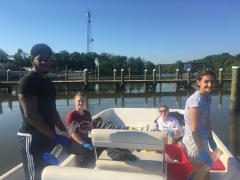Knauss legislative fellowships in Congress help build careers — and they're fun and educational. See our video and fact sheet for details.
Using Phytoplankton Communities to Track the Restoration of the Anacostia River
I tend to think of phytoplankton as the “forests” of an aquatic environment. Much like trees in a terrestrial ecosystem, phytoplankton form the base of the aquatic food web and are critically important to the overall structure and function of an ecosystem. Additionally, phytoplankton convert 40 to 50 percent of the carbon dioxide fixed globally, and therefore serve as a CO2 “sink”, much like forests do on land.
When I started to learn about phytoplankton as an undergraduate student, I was surprised to learn that not all types of phytoplankton are created equally. Some phytoplankton groups are known to support healthy food webs, while others may not be the best source of food for aquatic organisms. Given that certain phytoplankton species are more advantageous in an ecosystem than others, an abundance of “good” phytoplankton may be indicative of a thriving ecosystem. Since my undergraduate experience, I have become increasingly interested in using phytoplankton community composition as an indicator of water quality and ecosystem restoration.
As I began working on the Anacostia River as a graduate student, I knew that this ecosystem would be the ideal place for me to link ecological restoration to phytoplankton community composition. The Anacostia River is one of the most polluted tributaries in the Chesapeake Bay; however, restoration efforts in recent years have focused on improving this river system’s health.
One large-scale project designed to improve water quality is the Anacostia River Tunnel Project. The District of Columbia Water and Sewer Authority implemented the Anacostia River Tunnel Project in March 2018 to divert sewage and stormwater effluent to a wastewater treatment plant. The tunnel should reduce the amount of nutrients entering the Anacostia River, which will improve the water quality in this river system. I have made it my goal to track the expected improvements in ecosystem health by analyzing the microscopic phytoplankton that are present at different months throughout the year.
While a few studies have sought to link Anacostia River phytoplankton community composition to nutrient availability in the past, the changes in nutrient concentration (or phytoplankton “food”) that are expected to occur after the implementation of the tunnel may affect these community-level responses. In other words, how will less nitrogen and phosphorus coming into the river affect the phytoplankton already there, and the growth of new populations? River systems need phytoplankton, but too much causes problems. It can block light for bay grasses and interfere with food webs. I have been conducting field experiments and participating in ongoing monitoring efforts to better characterize phytoplankton community responses to changes in nutrient abundance and form since the tunnel project began.
In July 2018 I conducted my first experiment, with the help of my lab group, the Anacostia Riverkeeper, and two undergraduate students from Gallaudet University, to determine how different nutrient additions would impact phytoplankton community composition in the Anacostia River. The students from Gallaudet were part of the Maryland Sea Grant Research Experiences for Undergraduates (REU) Program, which provides fifteen undergraduate students an opportunity to participate in research efforts on the Chesapeake Bay during the summer months.
The field-based study we conducted was part of a larger, Sea Grant-funded project to monitor the effectiveness of the Anacostia River Tunnel in reducing nutrient loads to the River. To begin this experiment, we filled 15 five-liter containers with water from the Anacostia River and transported these containers to Horn Point Laboratory on the Eastern Shore of Maryland. Once at the lab, we spiked the containers with different types of nutrients. For example, one of our containers was dosed with nitrogen in the form of nitrate (NO3-), while another container was dosed with nitrogen in the form of ammonium (NH4+). Each day, we collected phytoplankton cells from the containers on a filter. The phytoplankton cells captured on these filters were used to determine the relative abundances of the different phytoplankton groups. The abundance data obtained from each container were then compared to one another to determine how nutrient enrichment shaped phytoplankton community composition in the River.
Going forward, I plan to repeat this experiment in February so that I can compare the results obtained in the winter to those obtained in the summer. Temperature will likely play an important role in shaping phytoplankton communities in the river, as different phytoplankton species have different temperature and sunlight requirements (much like land plants). You would not find a palm tree in the Arctic!
Although the Anacostia River is constantly changing, manipulation experiments and current sampling efforts provide valuable information about the phytoplankton communities present in the river and about the responses of these communities to changes in temperature, nutrients, and other environmental factors. As restoration efforts continue on the river, shifts that lead to healthier phytoplankton communities may suggest that restoration efforts are successful in improving ecosystem health. Over time, I am hopeful that we will see healthy phytoplankton communities in the Anacostia River that will provide a strong foundation for a resilient and prosperous river ecosystem.
Photo, top left: Collecting water on the Anacostia River for the July 2018 nutrient enrichment experiment. From left to right: Mauricio Orozco (Gallaudet), Casey Peck (Gallaudet), Samantha Gleich (UMCES), and Olivia Anderson (Anacostia Riverkeeper intern). Photo Credit: Trey Sherard (Anacostia Riverkeeper)
See all posts to the Fellowship Experiences blog



